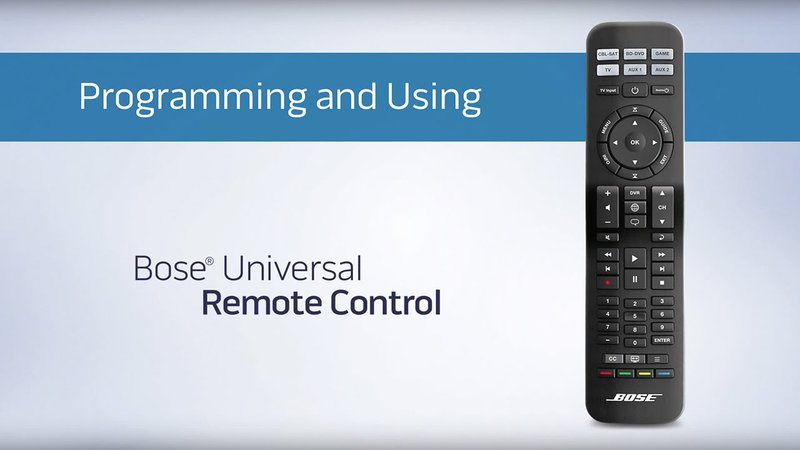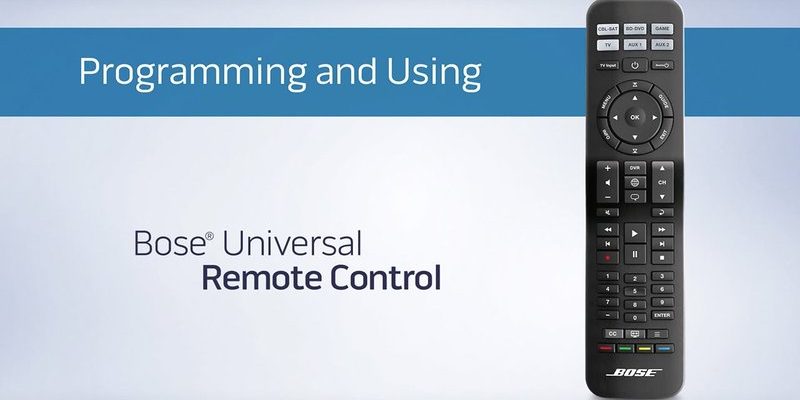
Programming a Bose soundbar remote isn’t quantum physics, but it does have a few steps that can trip people up if they rush. Maybe you’re a total beginner, or maybe you’ve had a remote-taming mishap in the past. Either way, I’ll walk you through what actually happens—from start to finish—so you don’t waste your precious binge-watching minutes fighting with tech. And hey, sometimes the biggest challenge is just finding fresh batteries.
What Does “Programming” a Bose Soundbar Remote Actually Mean?
Okay, so let’s get one thing straight: “programming” here doesn’t mean writing code like a hacker in a Hollywood movie (although, wouldn’t that be cool?). In the world of Bose and soundbars, programming a remote is just about syncing it to control your soundbar, TV, or other connected devices. Honestly, it’s mostly about pressing the right buttons, in the right order, and sometimes entering a secret code—no black hoodies or Matrix-style typing required.
You might be using the original remote that came with your Bose soundbar, or maybe you’ve picked up a universal remote from another brand. Either way, the process is surprisingly similar. The goal? Get your remote to “talk” to each device without a bunch of drama. Think of it as teaching your dog a new trick: it just takes a bit of repetition and the right commands.
Some Bose remotes are what the tech world calls “universal remotes.” This means they can control more than just your soundbar—like your TV or Blu-ray player. That’s both a blessing and a curse; you can cut down on remote clutter, but there are a few more steps to get everything sorted. Don’t worry, we’ll break it all down, nice and easy.
How Long Does Programming Usually Take?
Here’s the thing: if you have the right code or if your remote supports automatic syncing, programming a Bose soundbar remote usually takes between 2 and 10 minutes. Yep, you read that right—sometimes it’s literally just two minutes. Other times, if things go sideways, it can take 15 or 20 minutes, especially if you have to try a few codes or troubleshoot a stubborn remote.
Why does it vary so much? Well, a lot depends on the exact remote you have:
- Original Bose remote: Usually the fastest—just follow the steps in the Bose manual and you’ll be up and running in no time.
- Universal remote: Can take a bit longer since you’ll need to find the right code for your soundbar. Sometimes, there’s a code search feature that makes it easier, but not always.
- Smart remotes: Remotes like the Bose Music app or certain third-party smart home remotes might require syncing over Wi-Fi or Bluetooth, which adds extra steps.
In a perfect world, everything works on the first try. In real life, sometimes you need to try a couple of codes or repeat a step because a button didn’t press fully. My advice? Set aside about 10–15 minutes the first time you do it, especially if you’re new to programming remotes.
Step-by-Step: How to Program Your Bose Soundbar Remote
Let me explain exactly how the typical programming process goes. I promise, you won’t need a PhD—just a bit of patience and maybe a fresh pair of AAA batteries (seriously, dead batteries are the cause of 99% of remote headaches). Here’s a quick overview:
- Step 1: Get the remote and soundbar ready. Make sure both have power. If you’re using a universal remote, pop in new batteries. It feels silly, but low battery causes all sorts of weird problems.
- Step 2: Access programming mode. This usually means holding down a button (like “Setup” or “Soundbar”) for a few seconds until a light blinks. Each remote is a little different, so check your manual if you can.
- Step 3: Enter the code. For universal remotes, you’ll need to enter a manufacturer code (these are in the remote’s instruction booklet or online). For Bose remotes, sometimes you just select the device and the remote steps through codes automatically.
- Step 4: Test it out. Try adjusting the volume, switching inputs, and powering your soundbar on and off. If everything works, congrats! If not, repeat the process with the next code.
Here’s a personal example: I once helped my parents program their Bose remote to work with an older TV. The first code didn’t work—nothing happened when we pressed Volume. But the second code got it working perfectly. It took about 7 minutes, most of which was just us reminiscing about how much easier remote controls were in the 90s (were they, though?).
Common Roadblocks and How to Troubleshoot Them
If it all worked perfectly every time, life would be a dream. But of course, sometimes there’s a hiccup. Maybe the remote doesn’t sync. Maybe the soundbar ignores your heroic button-pressing. Maybe the batteries are fine, but it still refuses to cooperate.
Here’s where you become the remote whisperer. Most problems fall into three buckets:
- Wrong code: Double-check that you’re using a code for the right model. Some Bose soundbars have very similar names and numbers, which can trip people up.
- Button timing: On some remotes, you need to press and hold the programming button for a precise number of seconds. If you let go too early (or too late!), it won’t register. I’ve learned this one the hard way.
- Stubborn batteries: Even if your remote lights up, weak batteries can mess up the signal. Try a fresh set—seriously, it’s worth it.
If you start to feel frustrated, take a breather! Sometimes stepping away for a couple of minutes is the magic trick you need.
And if things are really going sideways, there’s usually a “reset” method in the manual (or online) that wipes the remote’s memory, so you can start over from scratch.
The Secret Sauce: Codes, Pairing, and Syncing
You might be wondering why there are so many codes involved. Here’s the deal: remotes use manufacturer codes to “speak” the same language as your devices. Bose provides these codes in the manual; universal remotes usually have a massive list online or in the box.
Now, some newer remotes skip the code-finding process entirely and have an “auto-search” or “sync” feature. Basically, you hold a button and the remote cycles through codes automatically, stopping when your soundbar responds correctly. Super handy, but sometimes you have to be quick to catch it when the right code is found.
Pairing over Bluetooth (for smart remotes or apps) is another flavor of the same thing. Open the pairing menu on your soundbar, then follow the app’s instructions to connect. This can take a minute or so, and you might need to troubleshoot if your Wi-Fi or Bluetooth is spotty.
If you ever feel buried under a mountain of codes, remember: someone out there has programmed a remote with even more codes for even stranger devices (like that one guy syncing his old VCR).
Brand Remote vs. Universal Remote: A Real-World Comparison
Let’s talk about why programming times can vary between an original Bose remote and a universal one. Using the remote that *came* with your Bose soundbar? That’s usually the smoothest ride. Everything is designed to work together, so the process is often just pressing “Pair” or “Sync” and waiting for a light to blink.
Universal remotes, though, are like the Swiss Army knives of home theater. They work with tons of brands—but that means more codes, more combinations, and a higher chance of a little trial and error. You’ll need to scroll through longer code lists, and sometimes run into features that don’t work (like a missing input switch or sound mode button).
Some high-end universal remotes (like Logitech Harmony, if you’ve heard of them) even let you program everything from a computer or phone app. That sounds slick, but honestly, by the time you’ve downloaded the software and signed in, the original remote would probably already be done.
Quick Tips For Speedier Programming
If you’re impatient (I get it), here are a few pro tips to shave off some minutes—or at least make the process less painful:
- Have your codes ready. Search online or in your manual before you start, so you’re not flipping pages mid-program.
- Keep batteries on standby. Trust me, you’ll thank yourself later.
- Use good lighting. It sounds silly, but being able to read all those tiny remote labels helps avoid mistakes.
- Check connections. Make sure your soundbar is plugged in, turned on, and not hidden behind furniture (IR remotes can be line-of-sight picky).
- Stay patient. Sometimes, it’s just a process of elimination—and every failed code brings you closer to the winner.
And if you still feel stuck, Bose support and user forums can be surprising lifesavers. There’s a good chance someone has faced the exact same code or syncing issue and can share a fix.
Wrapping It Up: Remote Programming Doesn’t Have to Be a Chore
So there you have it. Programming a Bose soundbar remote is usually a quick deal—most folks can be up and running in under 10 minutes if everything goes smoothly. Sure, there are a few moments where things might get a little finicky (especially if codes aren’t cooperating or the batteries have seen better days). But overall, it’s just a matter of following some simple steps and not panicking when it doesn’t work on the first try.
Honestly, the hardest part might just be choosing what to watch once your remote is working perfectly. So go ahead, grab your favorite snacks, and enjoy that sweet sound—remote in hand, frustration firmly in the rearview mirror.
